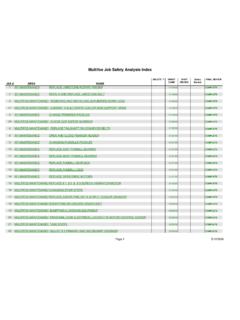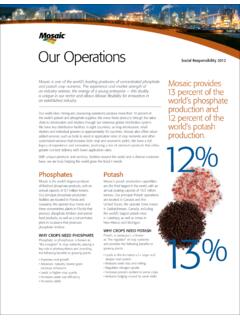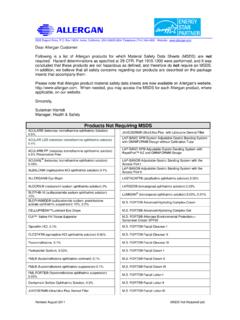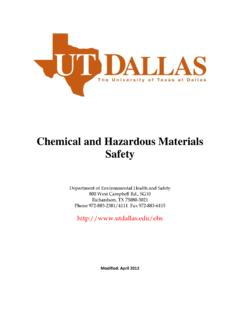Transcription of Material Safety Data Sheet PRODUCT UREA …
1 Material Safety data Sheet PRODUCT . urea LIQUOR 23-0-0. Emergency Telephone Number CHEMTREC 1-800-424-9300 (24 hours). SECTION 1 - PRODUCT IDENTIFICATION. Trade Name: urea LIQUOR 23-0-0. Description: An aqueous solution of an amide NFPA 704M/HMIS Rating: 1/1 Health 0/0 Flammability 0/0 Reactivity 0/Other 0=Insignificant 1=Slight 2=Moderate 3=High 4=Extreme SECTION 2 - COMPOSITION / INGREDIENT INFORMATION. Our hazard evaluation of the ingredient(s) under OSHA's Hazard Communication Rule, 29 CFR. has found none of the ingredient(s) hazardous. SECTION 3 - HAZARD IDENTIFICATION EMERGENCY OVERVIEW: Caution: May cause irritation to skin and eyes. Avoid contact with skin, eyes, and clothing. Avoid prolonged or repeated breathing of vapor. Use with adequate ventilation. Do not take internally. Empty containers may contain residual PRODUCT .
2 Do not reuse container unless properly reconditioned. Primary Route(s) of Exposure: Eye, Skin, Inhalation Eye Contact: Can cause mild, short-lasting irritation. Skin Contact: May cause irritation with prolonged contact. Inhalation: May cause irritation to the respiratory tract and lungs. SYMPTOMS OF EXPOSURE: A review of available data does not identify any symptoms from exposure not previously mentioned. Aggravation of Existing Conditions: A review of available data does not identify any worsening of existing conditions. SECTION 4 - FIRST AID INFORMATION. Eyes: Flush with water for 15 minutes. Call a physician. Skin: Wash thoroughly with soap and rinse with water. Call a physician. Ingestion: Do not induce vomiting. Give water. Call a physician. Inhalation: Remove to fresh air. Treat symptoms. Call a physician. Note To Physician: Based on the individual reactions of the patient, the physician's judgment should be used to control symptoms and clinical condition.
3 Caution: If unconscious, having trouble breathing or in convulsions, do not induce vomiting or give water. SECTION 5 - FIRE FIGHTING. Flash Point: None Extinguishing Media: This PRODUCT would not be expected to burn unless all the water is boiled away. The remaining organics may be ignitable. Use water to cool containers exposed to fire. Unusual Fire and Explosion Hazard: May evolve CO, CO2, NOx, ammonia, and cyanuric acid under fire conditions. SECTION 6 - ACCIDENTAL RELEASE MEASURES. In case of transportation accidents, call the following 24-hour telephone number: (CHEMTREC). SPILL CONTROL AND RECOVERY: Small Liquid Spills: Contain with absorbent Material , such as clay, soil or any commercially available absorbent. Shovel reclaimed liquid and absorbent into recovery or salvage drums for disposal. Refer to CERCLA in Section 15.
4 Large Liquid Spills: Dike to prevent further movement and reclaim into recovery or salvage drums or tank truck for disposal. Refer to CERCLA in Section 15. SECTION 7 - HANDLING AND STORAGE. Handling: Avoid contact with skin, eyes, and clothing. Storage: Keep container closed when not in use. SECTION 8 - EXPOSURE CONTROLS / PERSONAL PROTECTION. Respiratory Protection: Respiratory protection is not normally needed since the volatility and toxicity are low. If significant mists are generated, use either chemical cartridge respirator with a dust/mist prefilter or supplied air. For large spills, entry into large tanks, vessels or enclosed small spaces with inadequate ventilation, a positive pressure, self-contained breathing apparatus is recommended. Ventilation: General ventilation is recommended. Protective Equipment: Use impermeable gloves and chemical splash goggles when attaching feeding equipment, doing maintenance or handling PRODUCT .
5 Examples of impermeable gloves available on the market are neoprene, nitrile, PVC, natural rubber, viton and butyl (compatibility studies havenot been performed). The availability of an eye wash fountain and Safety shower is recommended. If clothing is contaminated, remove clothing and thoroughly wash the affected area. Launder contaminated clothing before reuse. SECTION 9 - PHYSICAL AND CHEMICAL PROPERTIES. Color: Clear, colorless Form: Liquid Density: lbs/gal. Specific Gravity: @ 77 Degrees F ASTM D-1298 Ph (NEAT)= ASTM E-70. Viscosity: 3 cps @ 72 Degrees F ASTM D-2983. Flash Point: None Crystallization Point: 60 Degrees F. Note: These physical properties are typical values for this PRODUCT . SECTION 10 - STABILITY AND REACTIVITY. Incompatibility: Avoid contact with strong oxidizers (eg. chlorine, peroxides, chromates, nitric acid, perchlorates, concentrated oxygen, permanganates) which can generate heat, fires, explosions and the release of toxic fumes.
6 Thermal Decomposition Products: In the event of combustion CO, CO2, NOx, ammonia, and cyanuric acid may be formed. Do not breathe smoke or fumes. Wear suitable protective equipment. SECTION 11 - TOXICOLOGICAL INFORMATION. Significant Routes of Exposure: Ingestion, Inhalation Toxicity to Animals: Acute oral toxicity (LD50): 14300 mg/kg (Rat.). Under controlled feeding conditions, urea is used as a nutritional supplement in cattle and other animals. The toxic dose in cattle given urea for the first time is considered to be g/kg or a total of 100-200 g. Mature bullocks can digest as much as 400 g a day without ill effect. As little as 50 g may cause adverse effects in cattle not accustomed to it. Animal Antidote and Emergency Treatment: In animals, the cold water - acetic acid treatment may work. The adult cow is given 19-38.
7 Liters cold water and liters of 5% acetic acid (vinegar) orally. This treatment limits absorption of ammonia from the rumen by diluting the rumen contents and slowing the rate of hydrolysis of urea by decreasing rumen pH and temperature. The treatment also promotes urine flow that, if maintained by fluid therapy, may assure recovery from urea toxicity. Gaseous or fluid bloat should be relieved before pumping water into the rumen. Consult your veterinarian immediately. Special Remarks on Toxicity to Animals: Low toxicity for humans or animals. urea ingestion may be toxic to mammals and birds at body burdens of several thousands of mg/kg. urea is used in small quantities as a feed supplement for livestock. Other Effects on Humans: Our database contains no additional remark on the toxicity of this PRODUCT Special Remarks on Chronic Effects on Humans: No effects Special Remarks on Other Effects on Humans: May cause irritation of the mucous membranes and upper respiratory tract.
8 SECTION 12 - ECOLOGICAL INFORMATION. If released into the environment, see CERCLA in Section 15. SECTION 13 - DISPOSAL CONSIDERATIONS. Disposal: If this PRODUCT becomes a waste, it does not meet the criteria of a hazardous waste as defined under the Resource Conservation and Recovery Act (RCRA) 40 CFR 261, since it does not have the characteristics of Subpart C, nor is it listed under Subpart D. As a non-hazardous liquid waste, it should be solidified with stabilizing agents (such as sand, fly ash, or cement) so that no free liquid remains before disposal to an industrial waste landfill. A non-hazardous liquid waste can also be incinerated in accordance with local, state and federal regulations. SECTION 14 - TRANSPORTATION INFORMATION. Proper shipping name/hazard class may vary by packaging, properties, and mode of transportation.
9 Typical proper shipping names for this PRODUCT are: All Transportation Modes: PRODUCT is not regulated during transportation. SECTION 15 - REGULATORY INFORMATION. The following regulations apply to this PRODUCT . FEDERAL REGULATIONS: OSHA Hazard Communication Rule, 29 CFR : Based on our hazard evaluation, none of the ingredients in this PRODUCT are hazardous. CERCLA/Superfund, 40 CFR 117, 302: Notification of spills of this PRODUCT is not required. SARA/Superfund Amendments and Reauthorization Act of 1986 (Title III) Sections 302, 311, 312. and 313: Section 302 - Extremely Hazardous Substances (40 CFR 355): This PRODUCT does not contain ingredients listed in Appendix A and B as an Extremely Hazardous Substance. Sections 311 and 312 - Material Safety data Sheet Requirements (40 CFR 370): Our hazard evaluation has found that this PRODUCT is not hazardous under 29 CFR Under SARA 311 and 312, the EPA has established threshold quantities for the reporting of hazardous chemicals.
10 The current thresholds are: 500 pounds or the threshold planning quantity (TPQ), whichever is lower, for extremely hazardous substances and 10,000 pounds for all other hazardous chemicals. Section 313 - List of Toxic Chemicals (40 CFR 372): This PRODUCT does not contain ingredients on the List of Toxic Chemicals. Toxic Substances Control Act (TSCA): The chemical ingredients in this PRODUCT are on the 8(b) Inventory List (40 CFR 710). Resource Conservation and Recovery Act (RCRA), 40 CFR 261 Subpart C & D: Consult Section 13 for RCRA classification. Federal Water Pollution Control Act, Clean Water Act, 40 CFR / Formerly Sec. 307, 40 CFR. 116 / Formerly Sec. 311: None of the ingredients are specifically listed. Clean Air Act, Sec. 111 (40 CFR 60), Sec. 112 (40 CFR 61, 1990 Amendments), Sec. 611 (40 CFR. 82, Class I and II Ozone Depleting Substances): This PRODUCT contains the following ingredients covered by the Clean Air Act: urea - Section 111.

















